Lab Notes
Short stories and links shared by the scientists in our community
In fieldwork, other humans pose as much risk to LGBTQIA+ people as the elements
But there are steps allies can take to help
Jim McDougall via Flickr
Many of us biologists conduct fieldwork in diverse places, from Alaska to the tropics, from aiming to understand how microbes are responding to climate change in the boreal soils to learning about life history strategies and co-evolutionary arms races of bats, their ectoparasitic flies, and the ectoparasitic fungi living on those flies.
The days before fieldwork tend to be hectic: make a checklist to make sure you have everything you need, think about a plan B (and a plan C, just in case), anticipate drawbacks and plan on how to address them, and the list goes on and on. The day comes. You make it to your field site, you collect the samples you want, obtain the data you need, everything works out just like planned, and you make it back to the lab — safe, on time, and without going over your planned budget. This is how it should be, but it never really goes like that.
Fieldwork is one of the most exciting experiences about doing research. It is also, in many cases, high-risk. During fieldwork, many things can go wrong, and most of those things cannot be helped. We cannot control the appearances of massive puddles in the middle of the road, critically damaging our transportation vehicles. We cannot control the thunderstorm that makes our study organisms disappear when we finally arrive at a remote field site after hours of climbing a mud-covered mountain.
Sadly, this is not always the case for threats to our integrity as human beings, and we, as a scientific community, have done far too little to address this problem. People from underrepresented groups in the sciences such as people of color, women, and those who identify as LGBTQIA+ or gender nonconforming often are at higher risk of suffering abuse during fieldwork. This comes in the form of sexual harassment, sexual abuse, discrimination, and intimidation. Scientists who have experienced abuse often fear talking about it because they are traumatized and because they fear retaliation and backlash, especially if the perpetrators of abuse are colleagues or superiors — advisers and people at higher career stage.
In Spring 2018, we carried out an anonymous survey to collect testimonies of what scientists, specifically from the LGBTQIA+ community, experience during fieldwork. The idea for such a survey sprouted from concerns that sexual orientation or gender identity may play an unwanted or unwarranted role in people’s professional career. Especially during fieldwork, when Diversity and Inclusion Offices from our university campuses are far away, LGBTQIA+ researchers are exposed to people who may not agree with their sexual orientation or who do not understand why “he” may want to be addressed as “they.”
Responses revealed experiences ranging from discrimination to situations that made researchers decide to no longer perform fieldwork outside of safe places. This adds a whole new level to fieldwork stress, namely having to evaluate sites for their tolerance towards LGBTQIA+. In one story from fieldwork, men voiced discomfort because an openly gay man would share a room with them while, simultaneously, women felt uncomfortable due to the possibility of having to share a room with someone from the opposite sex. Another survey respondent described that they were fearful to carry out fieldwork in places that are recognized for their homophobic culture. These experiences leave people feeling isolated and rejected.
We present a few strategies that we can instill in STEM fields to avoid cases like these:
1) INFORM PEOPLE ABOUT LGBTQIA+. Erase any misinformation that may exist. For example, a gay man is not a threat to the sexuality of cisgender males. Institutions can facilitate trainings on diversity and inclusiveness and provide information on the LGBTQIA+ community to eliminate negative stereotypes.
2) HAVE SUFFICIENT FUNDING AVAILABLE FOR FIELDWORK. Although sometimes it's unavoidable to share rooms due to limited budget or space, if there is the possibility to do so, provide individual lodging for people traveling to fieldwork or conferences. Especially for those who ask for it.
3) DEVELOP AN EMERGENCY PROTOCOL. As a lab, department, or institution, develop a protocol that scientists can follow as a response to experiencing a threat to their integrity. Protocols like this should be part of a broader departmental or university-wide mission statement about equity in field work. The bar has been set high by this example of a mission statement written by University of California Irvine professor Kathleen Treseder.
4) AVOID INTOLERANT AREAS. It is important to note that this does not only apply to countries like Niger and Tunisia where discriminatory laws expose LGBTQIA+ individuals to the risk of death penalty. It also applies close to home, in the USA, where there is an ongoing debate about public restrooms and which one transgender people and people who identify as gender-nonconforming should use.
5) IMPLEMENT A ZERO-TOLERANCE POLICY. Inform everyone in your lab, department and institution that there is a zero-tolerance policy regarding abuse. A code of conduct with expected versus unaccepted behavior and practices should always be made available through trainings and in field stations.
A new test for cystic fibrosis takes just two minutes and a scrape across the forehead
Availability of better tests could lead to earlier diagnosis, which is crucial for effective management of the disease
Cystic fibrosis (CF) is a chronic condition which primarily affects the lungs and digestive system. A new study published in PNAS presents a new diagnostic method — the test takes just two minutes, is minimally invasive, requires no sample processing, and is highly accurate.
Every individual has two copies of the CFTR gene. In order to present with CF, both copies of the CFTR gene will contain mutations, resulting in a non-functional protein. Dysfunctional CFTR leads to a mucus build-up, resulting in persistent lung infections and other organ complications.
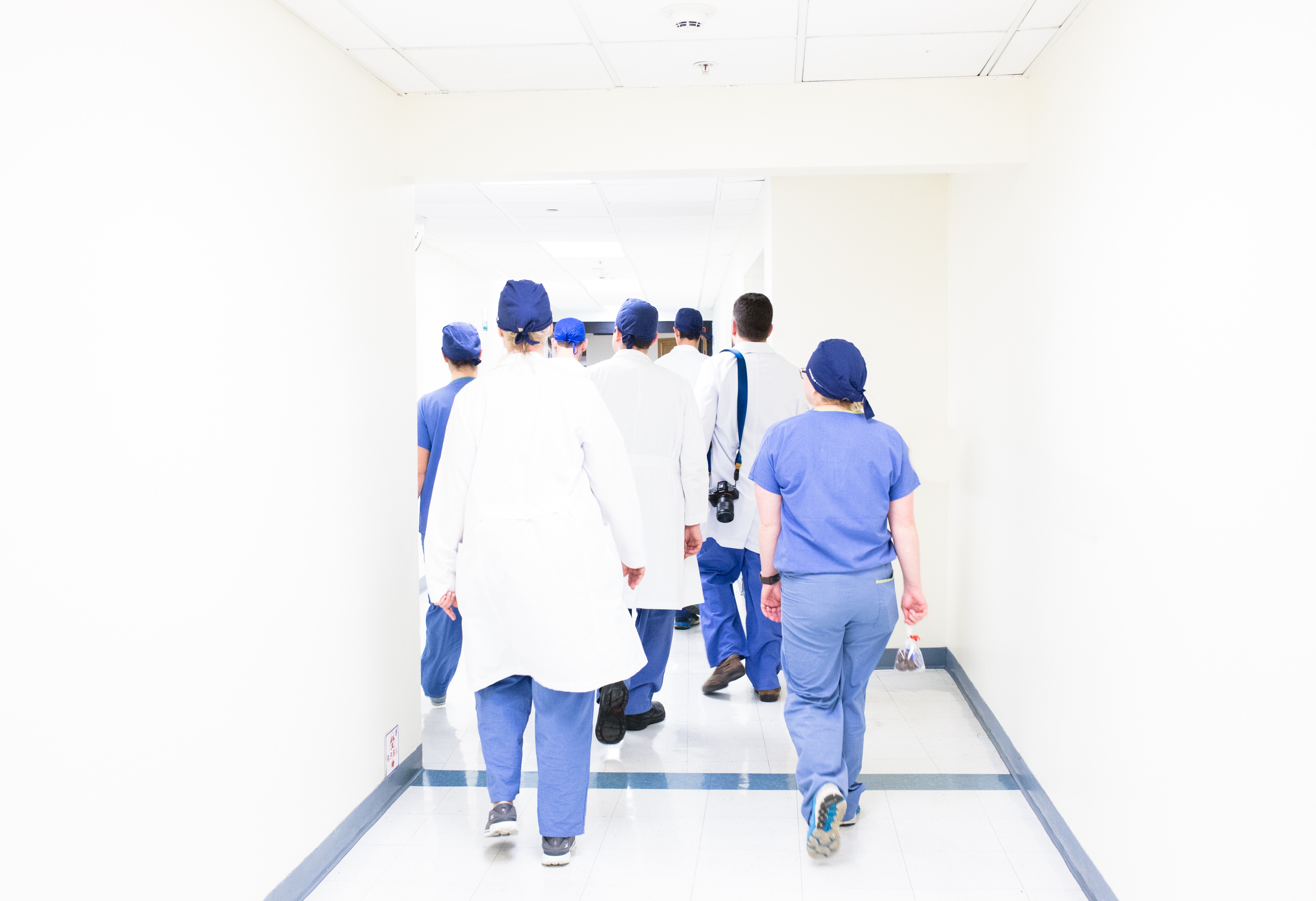
Luis Melendez on Unsplash.
While there is currently no cure for CF, an early diagnosis means that therapies, like antibiotics to prevent lung infections and mucus-thinning drugs, can be started earlier, improving an individual's quality of life and increasing life expectancy. Currently, a sweat chloride test is the gold standard for CF diagnosis; this test measures the amount of chloride (a component of salt) that is present in sweat.
First described in 1959, in this test, a colorless chemical and a small pulse of electrical simulation is applied to a small area of skin, over a five minute period, to prompt sweating. This sweat is then collected using filter paper or gauze for about half an hour, before being sent off to a laboratory for chloride analysis. This entire test can take up to three hours to complete. This test is also prone to technical errors, and requires a high degree of skill, especially when it comes to testing newborn children.
In this new study, researchers have developed a two minute test to diagnose CF. It involves gently swiping a standard microscope slide across an individual’s forehead to collect sweat products, instead of stimulating sweat. This five second scrape needs no additional sample processing — mass spectrometry can be directly applied to the microscope slide to analyze the sweat components, taking a total of two minutes to collect and test samples. Coupled with a machine learning algorithm, the researchers were able to correctly identify CF cases 98% of the time (with a 2% margin of error).
While this is simply a proof-of-concept, the study offers the potential of earlier, and less invasive, CF diagnosis. Will it replace the the sweat chloride test and become the gold standard for CF diagnosis? Only time — and additional testing — will tell.
If you're trying to catch an atom, try bending Heisenberg's uncertainty principle a little
Study author describes how quantum mechanics can be used to enhance the precision of measurements — and how other fields can benefit too
Making measurements is at the heart of doing science. Whether scientists are peeking at the inside of a cell or looking for habitable planets orbiting distant stars, all scientists would kill for a more sensitive detection device. In fact, scientists already spend a ton of energy trying to improve detection devices by eliminating noise or any unwanted signals which drown out the thing they are trying to measure.
But even if they could make the best detector possible by eliminating all sources of noise, scientists still wouldn't be able to get around a fundamental limit: the Heisenberg uncertainty principle. A consequence of quantum mechanics, the Heisenberg uncertainty principle states that if we measure one aspect of a system very precisely, for example, an object's position, then we lose information about a different aspect of the system, e.g., how fast the object is moving.
While this is a rule of quantum mechanics that can't be broken, quantum mechanics also provides a means of bending the rule. For example, if we really care about the position of an object, but not so much about the way it's moving, then we can put the object in a quantum state where the uncertainty of the position is reduced at the expense of greater uncertainty in the motion.
Let’s apply this concept to a pendulum: if we want to know how fast it is swinging back and forth, we could make a “quantum” pendulum that has lower uncertainty in its frequency of oscillation, or the swinging motion. As a consequence, though we would lose information about its energy, or the height of each swing.
This is what we explored in our Nature study earlier this year. A single ion, or charged atom, confined by electric fields, behaves just like this pendulum: it oscillates back and forth. By increasing the uncertainty in the ion’s energy, we were able to reduce the uncertainty in our measurement of its oscillation, thereby bending the rules of the pesky Heisenberg uncertainty principle in our favor.
Many things in our world behave just like this pendulum, and the demonstration of using quantum mechanics to enhance our measurement precision is an important step that many other fields can benefit from.
The secret to longevity may lie in a gene called REST
Centenarians were found to have almost double the amounts of REST in their neurons, as compared with those who only lived to their seventies
Findings from a recent study published in Nature reveal an unlikely physiological connection between the nervous system activity and longevity. Pattern shifts in the brain’s excitation levels have long been linked to specific neurological conditions such as epilepsy and dementia. Now, Bruce Yanker and his team describe for the first time these new implications of overactive brain signaling.
On a biochemical level, brain activity — which encompasses anything from thoughts, feelings or motor coordination — sets off a cascade of molecular pathways in neurons.
RE1-Silencing Transcription Factor, or REST, is a critical orchestrator of such signaling pathways, and acts by repressing genes associated with the excitation of neural circuits. Yanker and colleagues previously found that REST actually suppresses the onset of Alzheimer’s disease. REST does this by protecting neurons against oxidative stress.
Could REST levels, therefore, be a diagnostic marker of brain activity levels and consequently life span?
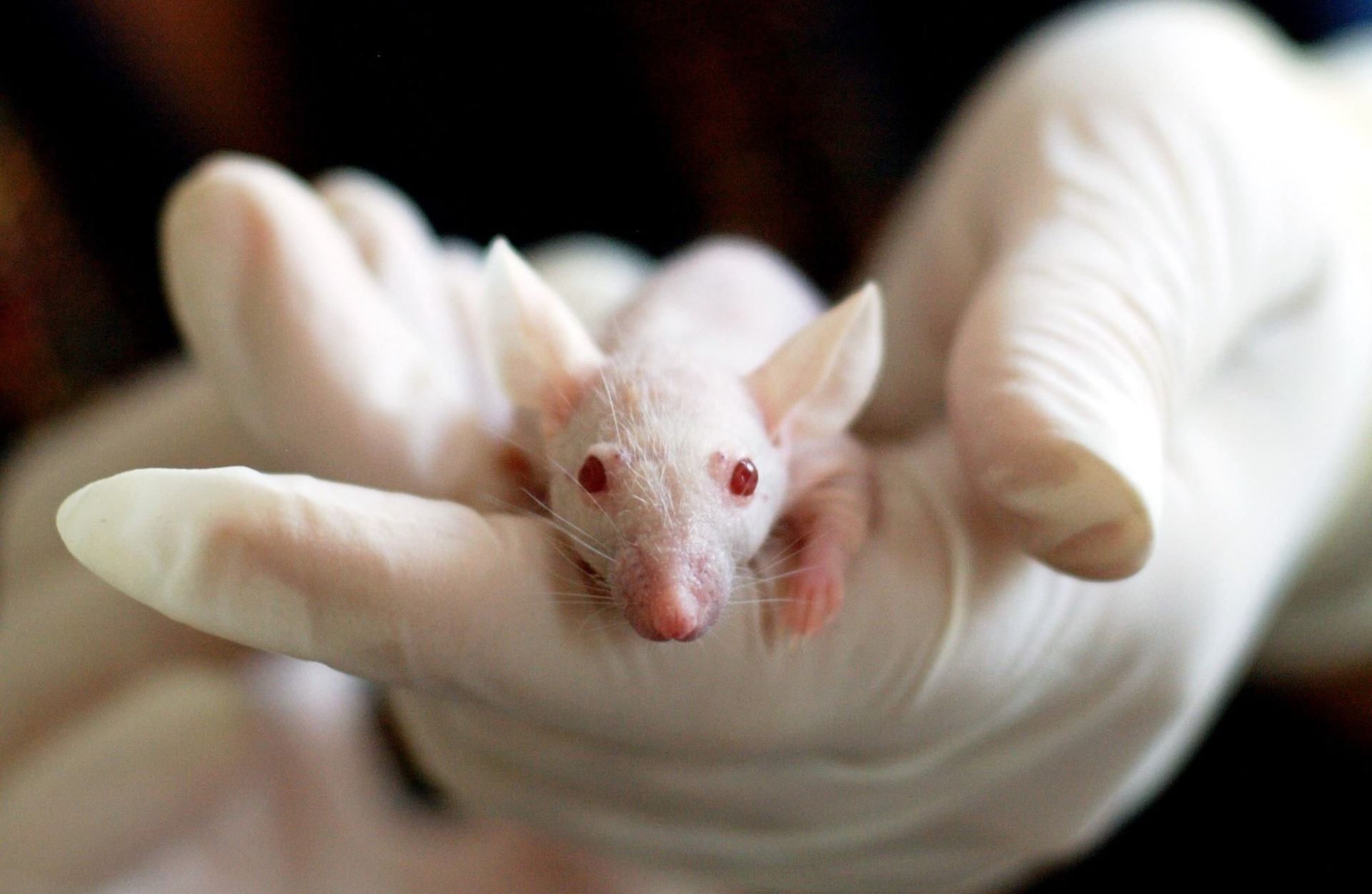
Model organisms used to investigate REST included genetically modified mice.
Image by Tibor Janosi Mozes from Pixabay
To test this hypothesis, the Yanker laboratory performed a comprehensive study using a variety of experimental models, including worms, genetically-modified mice and even brain tissue samples from individuals with lifespans of over a hundred years.
In these models, evidence supporting REST’s involvement in both neural excitation and biochemical pathways was found to be correlated with aging. REST was found to be a pivotal inhibitor of genes that stimulate effective communication between neurons.
Fascinatingly, REST was also strongly correlated with longevity, with centenarians found to have almost double the amounts of REST in the nuclei of their neurons as compared with those who only lived to their 70s.
Given this evidence, could our REST levels indicate how long we will live? Perhaps besides the molecular action of REST, could relaxation techniques such as meditation activate molecular processes that slow aging?
For now, the verdict is still unknown, but the authors suggest that REST may be a favorable therapeutic target for neurological conditions that are associated with overactive neural circuits, such as bipolar disorder.
Watch a Dragon launch towards the International Space Station today!
Takeoff is at 12:30PM EST. SpaceX's Dragon spacecraft is resupplying the ISS with stuff for new experiments and tech demos
There are two launches to the International Space Station (ISS) this week. Today, SpaceX's Dragon is launching to the ISS, carrying a bunch of different supplies, mostly resources for experiments ongoing at the ISS. Watch the launch here:
Among the resources being launched is the Hyperspectral Imager Suite (HISUI), a Japanese-designed instrument for imaging Earth from space. Look at it:
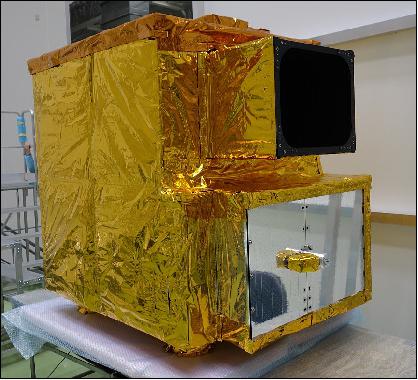
HISUI team
This launch is uncrewed, which is a shame 'cause check out SpaceX's wild, futuristic suit:

SpaceX/NASA
On Friday, an uncrewed Russian Soyuz Progress 74 craft launches with more supplies.
Researchers who collaborate with top scientists early on do better in their lifelong career
Though some researchers have questioned the study's methodology, including what constitutes a top scientist or a prestigious institution
Via Wikimedia
New research, out in Nature Communications, shows that working with a prestigious scientist can give junior researchers a competitive advantage throughout their careers.
By examining the publication data from over 20,000 scientists in the fields of cell biology, chemistry, physics, and neuroscience, this study found that early co-authorship predicts a higher probability of repeatedly coauthoring work with top-cited scientists. This then leads to a higher likelihood of becoming a top scientist twenty years later. Here, the researchers defined a "top" scientist as an individual belonging to the top 5% of cited authors in their discipline for that same year.
In addition, junior researchers affiliated with less prestigious institutions reap the most benefits from co-authorship with a top scientist.
The authors admit that they can’t completely control for whether these students who co-author with top scientists are likely to excel in their career regardless. It may just be that top scientists attract top students, the authors say. Additionally, as the researchers only studied scientists who began their careers between 1980 and 1998, it could be that science today is more meritocratic.
Furthermore, although working with a top scientist was a strong predictor, their early career citations, productivity, and institutional prestige were still very important.
However, the research may indicate that prestige bias from working with top scientists is unfairly and systematically benefiting some students over others, leading to inequality in career outcomes which does not reflect scientific ability.
On Twitter, Giacomo Livan, one of the study's co-authors, says that “coauthorship with a top scientist truly has potential career-altering consequences.”
But other researchers have a different perspective on the work, with some calling different aspects of the paper's methodology into question.
It may be that the research has wide implications for university hiring policies, paper co-authorship practices, and for students’ individual careers, but that remains to be seen.
Ancient Egyptians were drinking beer that looked just like modern brews
Researchers recently took a physical sample from the vats of Egypt’s oldest brewery establishment and analyzed the chemical components
By AussieActive on Unsplash
If you ever thought about going back in time and cracking open a cold one with the Egyptians, you might be surprised to find that ancient Egyptians drank a similar brewski to the ones on tap today.
The fermented drink featured prominently in Egyptian culture, a gift from the gods that graced pharaohs’ tombs and became the staple, everyday drink for men, women and children. To further probe the ancient Egyptian beer recipe, researchers recently took a physical sample from the vats of Egypt’s oldest brewery establishment (with a production volume reaching 650 bottles per vat!) and analyzed the chemical components of the preserved sludge.
Located in the Heirakonpolis archeological site near modern-day Edfu, archaeologists unearthed one of the oldest-known Egyptian breweries and earliest large-scale brewing site in the world in 2003, consisting of five free-standing ceramic vats. The vats had a thick, black film coating the interior. Early botanical analysis identified several components from the sludge, including emmer wheat, the staple ingredient of beer-making, and barley. However, the researchers analyzed the chemical composition further using instrumental methods, like gas chromatography-mass spectrometry and infrared spectroscopy, and discovered interesting additives.
The researchers found that more than a quarter of the total sample consisted of phosphoric acid. Phosphoric acid is commonly used today as a drink preservative and flavor enhancer, originating from hops in modern-day beer. Interesting, the previously oldest-known usage of phosphoric acid in alcoholic fermentation was in Crete, dating to approx. 1700 BCE. These Egyptian samples pre-date those by about 2000 years (~3600 BCE).
Further analysis identified other volatile organic acids and esters found in modern-day beer (caprylic acid, capric acid, laurate, and geranyl acetone to name a few) and bourbon whiskey (γ-nonalactone, which creates a coconut-like smell). Amino acids additionally accounted for 27.4% of the sample, with proline consisting of the majority (25.3%) of the amino acids. Proline is enriched in fruits, and previous evidence showed the addition of dates and grapes in ancient Egyptian beer residues, though botanical analysis has not confirmed this.
Though we know a lot about ancient Egypt, this is the first time scientists have shown that ancient Egyptians (perhaps) purposefully added barley, because its fermentation and subsequent phosphoric acid release preserved the all-important beverage and prevented rapid spoilage.
Forget pumpkin spice lattes — there are pumpkin toadlets living among us
These weird and wonderful amphibians are small enough to fit on a penny
By this time of year, you probably think you’ve seen all of the pumpkin things that could ever exist: pumpkin pie, pumpkin candles – there’s even pumpkin spice spam. But you might not have seen a pumpkin toadlet (Brachycephalus ephippium). These weird and wonderful amphibians are native to eastern Brazil and are small enough to fit on a penny.
This year, scientists discovered that the toadlets (like some chameleons) have bones that glow! Although fluorescent bones are not unique to these toadlets, thin, light-colored skin combined with bones that are “exceptionally fluorescent” compared to closely related species means that the glow can be seen in living animals.
Scientists don’t know why the pumpkin toadlets evolved this way, but they have a few guesses. These fluorescent bones might be used as visual communication – pumpkin toadlets rely heavily on vision due to underdeveloped ears. In fact, researchers showed that they appear to be unable to hear their own high-frequency mating calls! Another hypothesis is that the fluorescent bones serve as a warning to predators that the toadlets are highly toxic.
Conquistadors brought disease to the pumpkins and squash of the Americas
Cucumber disease, brought by invaders, jumped to native agriculture
Conquistadors brought new human diseases like smallpox and cholera when they invaded North and South America. They also brought infections to local agriculture.
Bacterial wilt is a disease that can infect Curcurbita plants, like pumpkins, squash, and gourds. It also infects plants in the genus Cucumis, things like cucumber and muskmelon. Caused by the bacteria Erwinia tracheiphila, infected plants wilt, turn yellow and brown around the edges, and die off. The disease progresses down the vine until an entire crop could be lost. It is only transmitted from bites of the leaf beetle (the bacteria survives winter by living in the beetles' guts). Economic losses from bacterial wilt numbers in the millions of dollars.
E. tracheiphila is an unusual bacteria: its range is today limited to the Midwestern and eastern portions of North America, even though susceptible plants are distributed all over the world. When they analyzed the genetic diversity of the Erwinia bacteria, in search of an explanation for this unusually limited range, scientists last year found something unusual.
They found that Erwinia can be assigned to three related groups, but that overall there wasn't much genetic diversity in the bacteria, and genetic traits that are usually rare were overrepresented. These are two clues that the bacteria went through a "bottleneck," where a large percentage of the population died off, with the survivors eventually rebounding. They also found that cucumbers, a plant native to Europe, Asia, and Australia but absent from North America until the 1500s, could be infected by all three Erwinia groups, but pumpkins and squashes couldn't.
The scientists infer that the newly introduced cucumbers, brought by conquistadors in the 1500s, acted as a reservoir for Erwinia. Moving from Europe bottlenecked Erwinia, but it grew and diversified into infecting local plants native to the Americas. It had safe harbor in cucumbers until it developed the ability to spread elsewhere. In the same way that colonizers brought human diseases like smallpox and measles, they brought bacterial wilt to the crops.
So, if your squash is sick this Thanksgiving, you'll know who to blame.
New research shows how protein aggregates destroy muscle cells
These findings have important implications for the treatment of myofibrillar myopathies, a set of diseases that affect the muscles
Photo by Dmitry Dreyer on Unsplash
In neurodegenerative diseases like Alzheimers and Parkinson’s, accumulation of aberrant proteins leads to the death of neurons. This same disease process can also be observed in muscles, leading to the break down of muscle cells. One such class of degenerative diseases that affect the muscles are called myofibrillar myopathies (MFMs).
A new study by researchers at Washington University in St. Louis and University College London has looked at aggregates of proteins in muscle cells to understand how a protein called desmin is involved in muscle degeneration. Based on a host of genetic and structural clues, they suspected that desmin could assemble in muscles in a similar way to how other protein aggregates form in the brain. They ultimately found that desmin aggregates can destroy muscle cells.
To do this, they first used an algorithm to help them predict forms of desmin they could use to study protein aggregation. Next, in order to look for and measure these aggregations, they used various types of spectroscopy and microscopy. They observed not only desmin aggregates but also the presence of prominent fibrils, or long, thin protein fibers. They were also interested in exactly how desmin aggregated: for example, did a few proteins clump together and then recruit others to join them, or does the aggregate form all at once? Finally, they tested whether the desmin fibrils that they had observed were toxic to skeletal muscle cells. When the desmin aggregates were added, they saw that the muscle fibers collapsed.
This research may help us understand how to more effectively treat MFMs. From a therapeutic standpoint, having a clear picture how these aggregates come together can lead to development of inhibitor drugs. Although MFMs are rare, they can be extraordinarily painful and be life threatening, so advances in treatment of these diseases would substantially help many people.
A science holiday guide for the nerd in your life
Show people how much they mean to you with brain games, microbe toys, animal art, and more
Photo by freestocks.org on Unsplash
It's easy to give thoughtless gifts. This year, give thoughtful gifts: science gifts! They're experimentally validated as wonderful*. This is Massive's 2019 holiday science shopping guide, with cool stuff from all around the science web, for Thanksgiving, Black Friday, Christmas, and beyond.

Illustrated by Matteo Farinella, Designed by Allan Lasser
Oh wow, so weird to see us at the top here. The coolest thing on this list is definitely the Women of Science Tarot deck we made. The deck features is itself a work of art, with beautiful original work from Matteo Farinella. Instead of the traditional face cards of many tarot decks, instead there are portraits of important women in science's history, including Mae Jemison, Rachel Carson, Marie Curie, Ada Lovelace, and more. If the the $75 price tag is too steep, there are also postcard packs with art from the deck and posters!
The geniuses at Genius Games make science-themed board games and card games. In Virulence, take on the role of a virus and replicate. Build atoms in Subatomic. Or, become the world's first programmers in Lovelace & Babbage. Massive has partnered with Genius Games to offer a 20% off coupon, just use the code MassiveScience20!
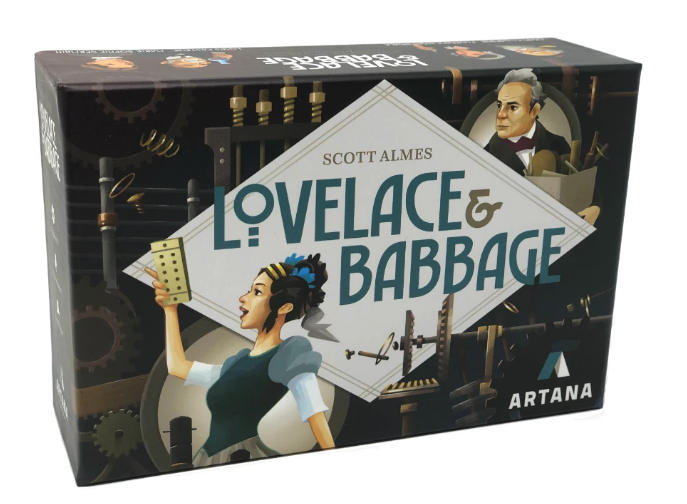
Courtesy of Genius Games
Two Photon
The undisputed champion of science art, pins, jewelry, and more. Our favorites include the neuroscience section, with brain pins and neuron necklaces, the virus t-shirt, and the nameplate necklaces, with options like "Scientist", "Doctor", and "Programmer."

What really sets Stitching Hew apart are their intricate stitch patterns, especially the Brainbrow Pyramidal Neuron Print, detailed enough to make Cajal blush. There are even downloadable stitch patterns or an entire beginner's science hand embroidery kit.
The prolific author and illustrator made one of our favorite books, Women in Science: 50 Fearless Pioneers Who Changed the World. But she also has other books, like Women in Art: 50 Fearless Creatives Who Changed the World, along with a whole pile of beautiful art prints to choose from.
If you're looking for an enamel pin to signal your allegiance to a particular scientific field, then this Etsy shop is for you! Packed with notebooks, postcards, stickers and an even a pocket mirror, the Science On A Postcard shop hosts some of our favourite pins, including ones that say science communicator, future scientist and that climate change is real.
You've undoubtedly seen their comics all over the great wide web, but Awkward Yeti's store is packed with goodies. There's tabletop games for the gamer who loves organs, some of the best stuffed organs (okay, the only stuffed organs) we've seen, like a uterus and an irritable bowel, and prints from the comic.

Courtesy of Awkward Yeti
You don't have to be a marine scientist to love their products. Waterlust carries leggings (with pockets!), rashguards and swim tops, board shorts, and more for people who love being in the water. Their products are great on land too — the fabric is soft and stretchy, and the leggings and shorts have a wide waistband that makes them incredibly comfortable for lounging around the house or going to the gym. Each pattern is dedicated to a specific marine conservation cause (my favorite is the Floridian Aquifer collection). Their products are partially made from recycled plastic bottles and the gear is shipped in eco-friendly packaging, making Waterlust a great choice for the outdoor enthusiasts in your life!
This science crochet shop is run by a PhD student at the University of Toronto, so you know the plushies are accurate. Oh and they're lovely too. Take the crocheted neuron necklace, or our personal favorite, the Islets of Langerhans crochet pattern.
Skype a Scientist is one of the best science outreach organizations we know of and they have the merch to match. If you love snakes and also Greek myths, consider this Medusa-as-a-scientist t-shirt. Or rather, if you're more of an astrobiology person, maybe the hardy tardigrade is more your speed.
If you're interested in science-themed underwear, this is the store for you. Consider the Maratus volans (aka the peacock spider) boxer briefs, which to be honest are kind of terrifying. If that's not your thing they also have phylogenetic tree skirts, intergalactic space dresses, and oh what the heck here's black widow underwear.
Perhaps something a bit more...meditative? Slow Dance is a frame that produces slow-motion, real-time movement. The creators say it helps lower stress and is quite good for meditation (we weren't just being cute).
*data not shown
A continuously updated list of bad genetics studies
Is there a gene for being a cat person? A dog person? A mean person? A selfish person?
Photo by bruce mars on Unsplash
When you read a story about scientists finding the "gene for" something, what you probably read about was a genome-wide association study or GWAS (pronounced "gee-was," but in my mind pronounced as one syllable, "gwas," or better, "gwaaaaaas", like spaaaaace). Gene sequencing is getting cheaper all the time and genetics is a vast and barely explored science. So, if you have an idea for something humans do and you want to know if there are genes "for" that behavior, you could do a GWAS. If, say, you wanted to know if there was a gene that explained why someone likes ranch dressing, you could gather a bunch of ranch-lovers, ranch-haters, and, I don't know, some ranch-agnostics as a control, and see if the ranch lovers had a gene that was more common than in any other groups. Maybe that's the gene for loving ranch. That would be a bad GWAS.
Here's a continuously updated list of bad GWAS studies. There are only five on here at first because I'm made of flesh and have a limited capacity for understanding things. Feel free to email more to me at your leisure:
A GWAS for same-sex sexual behavior
What purpose does this work have? I'm not sure, which is wild because the scientists spent a lot of time justifying their work. Sexual preferences isn't a pathology so...why does this exist? Does anyone go looking for genetic explanations for heterosexuality?
A GWAS for musical rhythm
If someone isn't good at dancing, maybe there's a genetic explanation for that. Or maybe they could just practice dancing.
A GWAS for being smart
Sorry it's actually not for being smart, which is a nebulous concept. It's for "educational achievement," a super rock solid measurement of...something. Probably being well-fed, wealthy, and white?
A GWAS for getting a lot of sleep and having a high IQ
If you see "IQ" anywhere you can just stop reading (not now, please keeping reading this). Having a high IQ doesn't mean anything. The findings from this study is that people who do have high IQs have flexible sleeping schedules. I don't know what that's supposed to mean to me.
A GWAS for being hot
I don't know.
Updated: November 21st, 2019
A GWAS for being rich
Have rich people evolved to be rich? I've heard of inherited wealth but this is ridiculous!
Updated: December 17th, 2019
These aren't new studies but a few I hadn't seen before:
A GWAS for being lonely and also being lonely plus overweight?
I...okay. " We identify 15 genomic loci (P < 5 × 10−8) for loneliness, and demonstrate a likely causal association between adiposity and increased susceptibility to loneliness and depressive symptoms."
A GWAS for being a morning person
Pitch: a GWAS for needing a nap sometime around 2:30PM or so.
Updated: January 6th, 2020
A twin study for having friends
While not a GWAS in the traditional sense, the authors of this twin study assume that the size of people's "friendship networks" can depend on their genes. It's not your fault that you weren't popular in high school, right?
Immune cells like to double up for stronger infection fighting power
Once thought to be experimental artifacts, these cell pairs could provide important insights into the immune system
NIAID
Scientists have long known that physical interactions between different types of immune cells are essential for proper functioning of the immune system. Yet for years, doublets — or pairs of cells — were often discarded in some types of experiments because scientists thought they were simply a failure of the processes and machines used to separate different cell types in the lab. A new study has countered this longstanding assumption, showing that cell doublets are probably not just a result of faulty lab equipment and instead are a naturally-occurring component of the immune system.
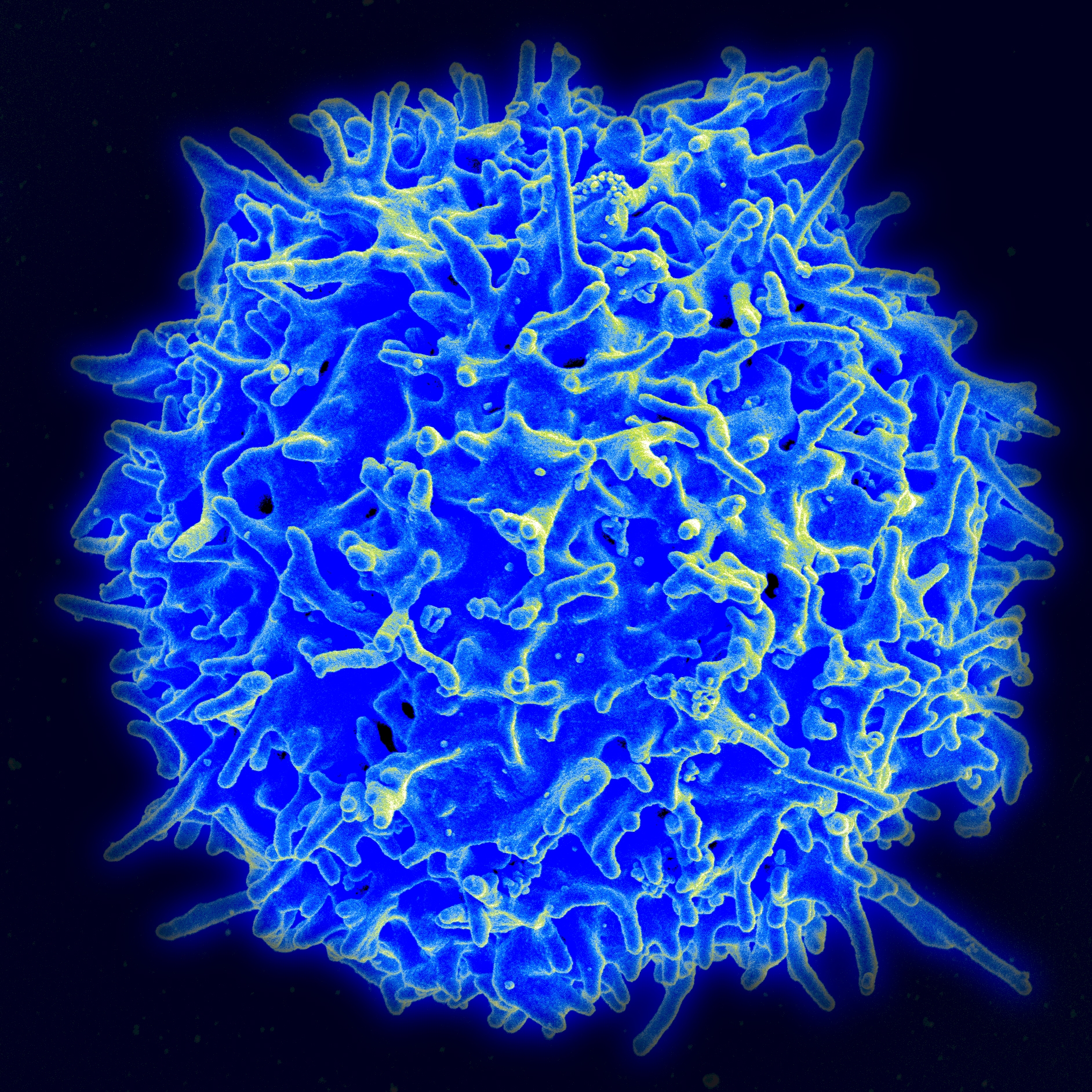
NIAID
Bjoern Peters’ group at the La Jolla Institute for Immunology in California uses a technique called flow cytometry to study immune cells. Immune cells fight off infections and come in more than a dozen varieties. Studying all of them together would be difficult, so the researchers separate them based on certain tags the cells carry, like sorting mail. Flow cytometry allows scientists to feed in a hodgepodge of cells and come away with neat little groups sorted by their tags.
The sorted cells are usually pretty happy by themselves and don’t stick to other cells in the group. Every once in a while, though, pairs of cells called doublets turn up. For years, doublets were discarded as artifacts of the flow cytometry process.
Peters’ lab, however, became interested in these doublets that were observed in flow cytometry experiments when they identified a strange group of immune cells. Although at first the strange cells appeared to be just T-cells, they were actually doublets formed by two types of immune cells called T-cells and monocytes. After some more careful separation and analysis, the group found that levels of these doublets were associated with infections like tuberculosis and dengue. Doublets could also be affected by recent vaccinations.
The researchers now plan to see if more doublets like these exist and use them to further study how immune cells work.
CRISPR technology for human gene editing is promising, but serious scientific and ethical concerns remain
Multiple sectors of society must be involved in the regulation and applications of CRISPR to medicine
Photo by Sérgio Rola on Unsplash
CRISPR-Cas9 has received global attention for its potential to eliminate genetic disorders, infectious diseases, and many other ailments that plague humans (pun intended). But in the realm of science, when something seems too good to be true, there are often important caveats. The current standing of gene editing technologies leaves many scientists wondering if we know enough about the genome and consequences of “genetic tampering” to do it in the name of betterment of mankind.
Recently, the US National Institutes of Health pledged $190 million to make gene editing more widespread. Last month, the story of a Russian couple, both of whom are deaf or partially-deaf and want to use CRISPR to genetically modify their embryos so that their future child is not, circulated around the world of science news. But we still do not know all of the potential adverse effects and consequences of gene editing human beings, leading some to argue that the regulation and applications of this important scientific technology cannot be left up to scientists.
The human genome is a complicated and intertwined set of information, and edits in one part of a gene may have downstream effects that we are currently unaware of. For example, gene editing can lead to large-scale deletions and rearrangements of genetic information that could lead to abnormal gene function and cell activity.
While the ability to edit and change the human genome is appealing to virtually every branch of medicine, serious ethical, social, and policy concerns surrounding CRISPR and other gene editing technologies must be grappled with alongside their scientific promise.
I want a new smartphone, but the human and environmental cost is giving me doubts
New gadgets are fun. They're also abysmally destructive
Photo by Bailey Kovac on Unsplash
I need a new phone. Like many of us with older model iPhones, my battery life is just a few hours and I've stopped updating the operating system to extend the phone's life. But I'm having a tough time pulling the trigger. It's not the cost (although that is hefty, especially on a grad student salary). It's not the hassle either. It's the environment.
Making smartphones, laptops, and other tech takes a lot of resources. This is partly due to the carbon emissions from the manufacturing process, but the biggest toll comes from the mining of the rare earth metals that make your phone work. If you're reading this on your phone right now, you're holding about 0.034 grams of gold, 0.34 grams of silver, and smaller amounts of palladium, platinum, yttrium, terbium, and gadolinium — among others. These are tiny amounts, but consider the demand for smartphones around the world.
All of these rare elements have to be mined from inside the Earth, in places like China and the Democratic Republic of Congo. Mining is hugely environmentally destructive: forests are decimated, the ground is disturbed, and water quality in the area takes a dive. Worse still, the cobalt mining industry in the DRC depends on child labor. And elsewhere in the DRC, mining for coltan, another smartphone ingredient, threatens a key population of Grauer's gorillas.
Now take these environmental risks, and combine them with the fact that the average lifespan of a smartphone is just two years, the length of your contract with your cell phone company. After that, if you're lucky, you get a "free" upgrade. Awesome, right? Sure, if you ignore the fact that the environmental impact of a new phone is about the same as using your old one for a decade.

The environmental impact of illegal gold mining in the Amazon
It's nearly impossible to live in the 21st century without contributing to environmental destruction and climate change. I am guilty as well — I eat meat and occasionally fly. But that doesn't mean that we should stop trying to do better by our planet, or ignore the consequences of our actions. This Christmas, I urge you to think carefully about that smartphone purchase, not matter what the Black Friday ads are telling you.
I know I am.
Soon, algae might absorb carbon dioxide emissions before they even leave the factory
Algae are efficient biofuel producers, and scientists are working on improving our algal-centered technology
Photo by John Mark Arnold on Unsplash
Researchers are always working on developing technologies to reduce carbon emissions to deal with the climate crisis. Recently, algae bioreactor technology has been highlighted as a way to convert carbon emissions from industries into biofuel and other useful by-products. But cost-effective methods for doing just this are needed to speed up the rate at which these new technologies are adopted.
Now, researchers at Pacific Northwest National Laboratory's (PNNL) Marine Sciences Laboratory in Sequim, Washington, aim to lower the cost of producing algae-based biofuels to $3/gasoline-gallon equivalent by 2030 by cultivating highly productive strains of algae. The PNNL's work on algal biofuels is funded and directed by the U.S. Department on Energy as part of the Algal DISCOVR project.
The algae technology eliminates challenges associated with existing carbon capture methods. Algae in the bioreactor use minimal resources: they depend solely on carbon emissions produced by industry and light to produce biofuel. Algae is thought to be 10-100 times more productive as compared to the non-food crops, such as switchgrass, used in current biofuel production. This means algae is capable taking up more carbon dioxide and producing more biofuel per acre, than these alternatives. Since they lack the tough fibrous structures of switchgrass and other plants, algae are also easier and cheaper to process. Other benefits of using algae for biofuel are that they don't take up agricultural land and don't require much water input.
Ideally, algal bioreactors could be installed in factories to capture the carbon dioxide as it is emitted. The company Hypergiant has already developed this type of reactor, which uses artificial intelligence to continually monitor and adjust airflow, the amount of light and carbon dioxide, temperature, and other parameters to maintain the optimal conditions for algae growth. There is hope for our future to be green, yet.
New research points to a simple way to diagnose autism, even in non-verbal patients
Measuring the brain's ability to toggle between two images is highly correlated to the severity of autism symptoms in study participants
Photo by Hal Gatewood on Unsplash
A recent study from researchers at Johns Hopkins University and Dartmouth College has identified a new marker for autism that could facilitate earlier diagnosis. The marker is a difference in the autistic brain’s capacity for binocular rivalry, which describes the visual cortex’s ability to process one image at a time when presented with multiple images at once. The brain's inability to ignore one of several competing stimuli is tied to the hypersensitivity to sensory input that is characteristic of autism.
Study participants were shown checkerboard patterns of different colors in their right and left eyes, and their visual processing of the images was measured through an electrode that picks up on brain signals. Autistic participants were much less able to toggle their focus between the two images, compared to neurotypical participants. Amazingly, the researchers found that the rate of binocular rivalry they measured was predictive of the severity of one’s symptoms, and using the data they could diagnose autism in study participants with 87% accuracy. A clear benefit of this study is that this marker is non-verbal, which means it can be used to evaluate young children who have not started talking yet as well as non-verbal adults.
While this work provides insight into the underlying neurological root of autism and establishes a new diagnostic tool, it’s important to remember that autism is not a problem to be solved. While the differences in the autistic brain may lead to social challenges, they also impart unique intellectual abilities.
How did our ancestors start walking upright?
A newly discovered species of ancient ape could shed light on the origins of human bipedalism
Barney Moss
In a recent Nature paper, a team of paleoanthropologists announced the discovery of a new fossil ape from Germany, which they named Danuvius guggenmosi. Dating to 11.62 million years ago, this little (17-31 kg) ape seems to have had an previously unknown way of moving through the trees.
One of the biggest open questions in paleoanthropology is how our ancestors evolved to walk upright. Our mode of locomotion, called obligate bipedalism, is unique among primates and our closest living relatives, the great apes, have very different ways of getting around.
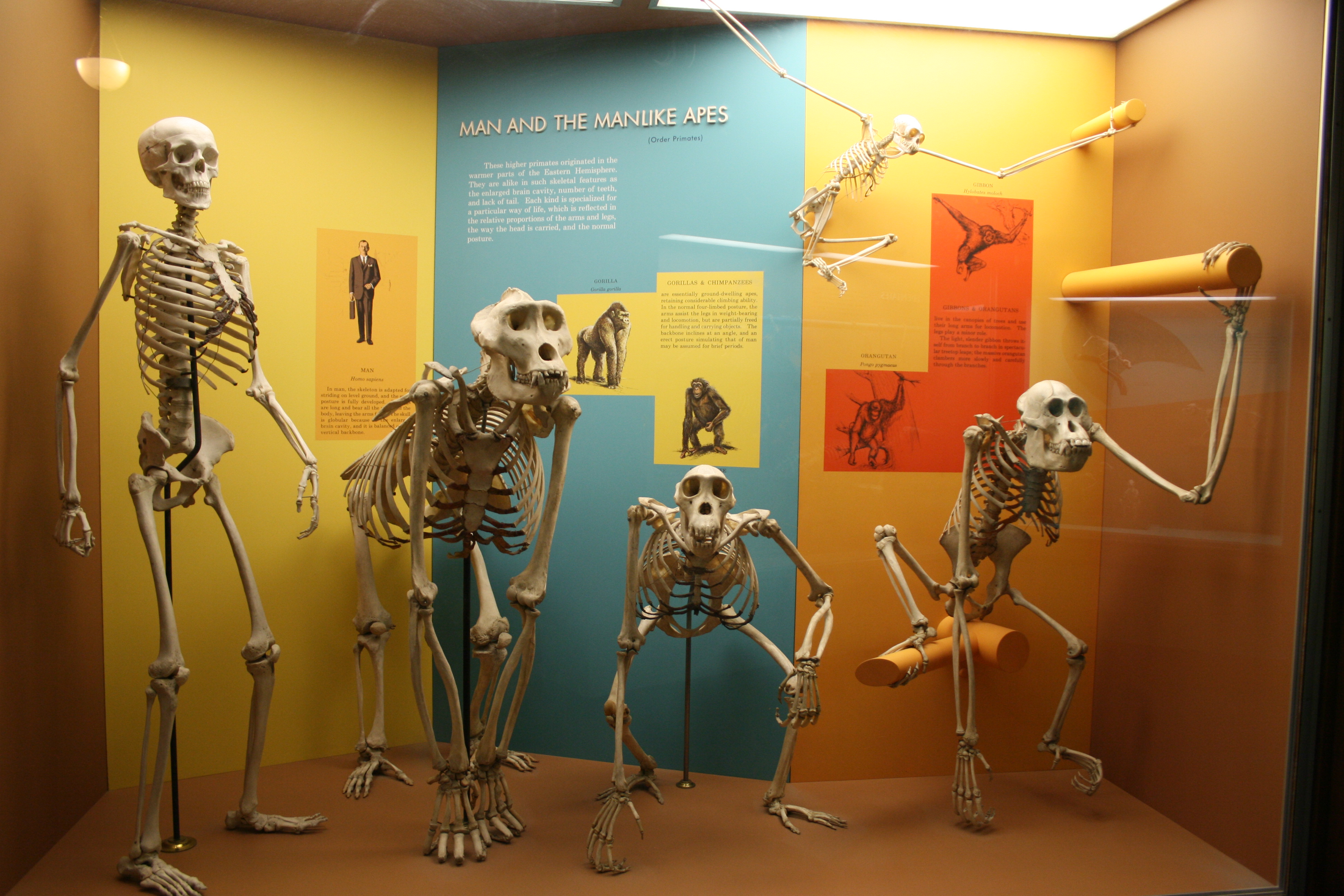
Gary Todd
So how did our last common ancestor with the great apes move? Were they upright, like us, or were they more reliant on using their arms, like the great apes?
The researchers who studied Danuvius suggested that it combined upright walking in the trees (aided by a grasping big toe) with the kinds of forelimb movements used by the great apes. They called this new kind of locomotor behavior "extended limb clambering" and wrote that it might be a potential candidate for the way the last common ancestor of humans and the great apes moved.
They haven't yet analyzed how this new ape might fit into the family tree, but its fossils are still helping to shed light on a complicated time in our evolutionary past.
Using the old-fashioned blueprint chemical process for modern art
The cyanotype printing process is not only still useful in the 21st century, it's still beautiful
Takeshi Moro
Have you ever wondered why we call floor plans and other diagrams “blueprints”? The term “blueprint” originates from the cyanotype printing process, which yields prints in vivid cyan-blue colors and was widely used to replicate complex technical drawings in the 19th and 20th centuries. While cyanotype printing could have been made obsolete by the invention of copy machines, artists today continue to use this process to create startling cyan images. For example, photographer Takeshi Moro exclusively used cyanotype to produce pieces for his 2013 exhibition “Wannsee in Berliner Blau.” The crude quality of the images was meant to transport the patrons to the time of the 1942 Wannsee Nazi Conference, and their blue hues were intended to invoke the sorrow of this era of history.
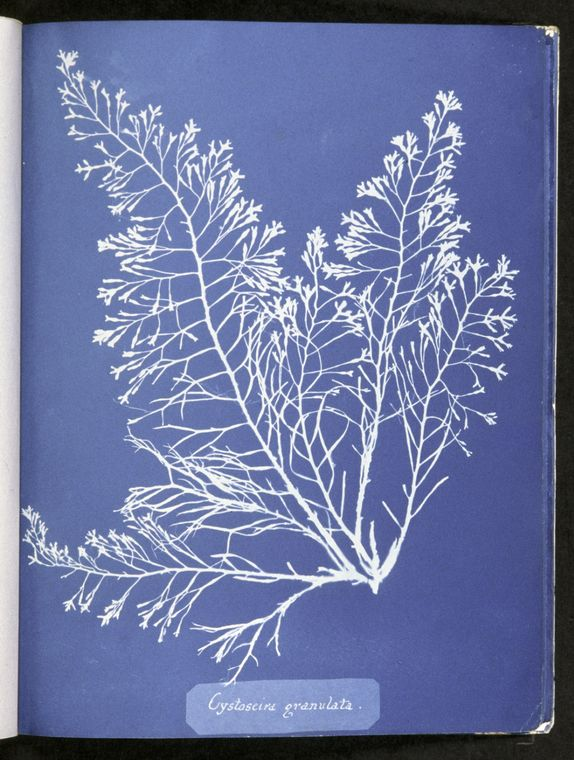
An example of cyanotype of algae done in the 19th century by Anna Atkins
New York Public Library
I helped Takeshi to develop images for the exhibition by making the cyanotype solution in the lab. I combined two chemicals, ferric ammonium citrate and potassium ferricyanide, at a fixed ratio. Takeshi then applied the solution to the photographic prints and exposed them to light (the duration of this exposure period and the intensity of the light will affect the contrast of the image). Together, the light and the citrate cause the iron atoms in the ferric ammonium citrate to lose an electron, making them more unstable and reactive toward the ferricyanide. This reaction yields a dye known as Prussian blue that saturates the print and produces a cyan-toned image.
Given that “photography” is now as simple as aiming your iPhone 11’s multiple cameras at an object and pressing a button, it’s refreshing to know that photographers continue to use cyanotype printing as a strategic artistic choice to elicit a specific emotional response from the viewer. And while it may have been inconvenient for Takeshi to enlist a chemist to assist in producing pieces for his exhibition, we agreed that the experience was very valuable because we both came to learn about and appreciate the other’s area of expertise. Cyanotype creates stunning images and opportunities for collaboration between artists and scientists—there’s no need to be blue!
Researchers optimized a reaction involving DEAD to reduce chemical waste
The Mitsunobu reaction is key to using alcohols in organic chemistry, but it also generates considerable chemical waste
By Chromatograph on Unsplash
Alcohols are heavily used in organic chemistry because they are cheap and widely available. However, they are also quite stable and react slowly. Before their use, alcohols require a pre-activation step, and one of the most common ways to do it is the Mitsunobu reaction.
This reaction involves the use of the chemical diethyl azodicarboxylate, which is known as DEAD in the chemistry community for its high toxicity. DEAD is used in a stoichiometric amount (i.e. a one-to-one ratio) with respect to the alcohol in this reaction. This means that if we want to modify 1,000 units of alcohol, we need 1,000 units of DEAD, which will consequently produce 1,000 units of chemical waste. This major drawback prevents the implementation of the Mitsunobu reaction on a larger industrial scale, especially in uses such as the production of drug candidates.
Recently, researchers at the University of Nottingham have managed to design and optimize a new way of carrying out the Mitsunobu reaction through the use of an organocatalyst. Here, an organocatalyst refers to an organic compound which can speed up a chemical reaction, but isn't consumed by the reaction. Specifically, the researchers designed a phosphine oxide compound to optimize the Mitsunobu reaction.
The way this newly optimized reaction works is the following: the alcohol is bound to the organocatalyst, which leads to the formation of "activated" alcohol. Once the alcohol is activated, it reacts much more quickly with a nucleophile (i.e. a chemical species which donates electrons), leading to the formation of the desired product and returns the organocatalyst to its original state. In this state, the organocatalyst can bind to a new unit of alcohol and repeats the reaction. This cycle keeps on repeating until all the alcohol units undergo activation and are used up.
Replacing DEAD with an organocatalyst not only has the advantages of removing a highly toxic and dangerous chemical compound, but also forms water as the only side-product. This newly optimized reaction was used to produce thiocarlide, a drug used to treat tuberculosis, which highlights the potential of this newly optimized reaction and its promising application on an industrial scale.
Fires explode across Australia as the continent records its first-ever day without rain
And they are predicted to get worse as the dry weather persists
80 trading 24 on Wikimedia Commons
Earlier this week, no rain fell anywhere in Australia for a full day. This was the first time in recorded history that no location on the continent received a drop of rain — and as a result, the wildfire situation, already dire, is growing still more severe.
While the IPCC has stated that we have 12 years to reduce carbon emissions substantially enough to mitigate the worst effects of climate change, in some ways the crisis is already here. In Australia, the dryness and hot air combined have raised fire warnings to "catastrophic". As of November 11th, there were over 80 fires raging across Australian states, and the number has climbed since then. A state of emergency has been declared in New South Wales, Australia's most populated state. As of now, at least four people have died and countless property damage has occurred, with the fire season projected to become even worse as the Australian summer arrives.
A tracker is keeping tabs on the Trump administration's assault on science
The Silencing Science Tracker has been compiling records since 2018
Photo by The Climate Reality Project on Unsplash
It's difficult to remember all the ways the Trump presidency has ignored, subverted, or kneecapped science in the United States. Picking a story that best exemplifies the administration's hostility towards evidence-based policy is like picking the perfect rock to smash your own head against.
There's the eviction of two US Department of Agriculture (USDA) research agencies from DC to Missouri, effectively firing career scientists who weren't willing to pick up their lives and move. There's the move to allow slaughterhouses to self-regulate themselves. And of course there have been countless ways that the administration has undermined the Environmental Protection Agency (EPA). This week the EPA announced its plan to relax coal industry regulations around waste disposal, which were put in place to prevent metal contamination in water supplies. Also this week the EPA announced new policies that would restrict what research could be used to base policy on. It's too much to keep track of.
Luckily you don't have to. The Silencing Science Tracker has been keeping diligent records on the Trump administration's behavior around science for almost two years. The tracker lists every instance of distorting science that's occurred at the federal and state level in the US since January 2018, founded on the one year anniversary of Donald Trump's inauguration. I spoke with Susan Rosenthal at the Sabin Center for Climate Change Law and Climate Science Legal Defense Fund at Columbia University, which houses the Tracker:
"[We're] seeing all these things, a lot of stuff about web pages being removed, and [scientists] were being asked to or were choosing to censor their work, to stop using certain words, from this fear of attracting attention from officials that were appointed by the new administration."
The Tracker only deals with absolute, concrete stuff. So even though the westward movement of USDA and Bureau of Land Management scientists out of DC has a strong air of suppression, since there's no hard evidence that the move was an act of repression, it's left out.
You can sort by state, agency, explanation given, and even by scientists affected. The amount of climate science being ignored or interfered with is so great that the scientists affected are simply categorized as "Climate," with 261 entries, or 201 "Other" entries. The depth and breadth of climate science suppression is breathtaking. Even Amtrak of all agencies has deleted references of climate change from reports, and withheld studies on the effects of climate change. Said Rosenthal:
"We have a lot of stuff to add, which is good for the Tracker, but obviously, is bad."
Science articles written by scientists perform as well as those written by journalists
Scientists are helping to fill a critical void and bringing unique perspectives to science communication
Photo by Amy Hirschi on Unsplash
Can scientists fill the void in science journalism? A new study posted on bioRxiv asked this exact question, and found that in terms of article engagement, scientists and journalists engage audiences at roughly equivalent rates. The researchers, led by PhD student Yael Baren-Ben David from the Technion-Israel Institute of Technology, looked at views, clicks, comments and time spent on the page as metrics of engagement, and compared equivalent articles written by scientists and professional journalists. For the two major Israeli online news sites that they studied, the audiences literally and figuratively “liked” articles equivalently no matter who wrote them.
As the number of professional science journalists has declined, scientists have fulfilled the important task of communicating science to the public. As a scientist writing for Massive, it’s reassuring to me to see data confirming that scientists can write in a way that engages the general public, and that the public responds positively.
The study authors note that while scientists can inform and share science news, they are not independent outsiders and have other limitations on their time and knowledge. Increasing the number of scientists writing articles may accelerate the decline of science journalists, and increase reliance on unpaid, outside sources. Despite these caveats, scientists can still play an important role in science communication. It only benefits society to hear their unique points of view.
To adapt to city life, snails in urban centres are more likely to be yellow than pink
Science-loving citizens helped researchers look at how urban environments affect snails
Wikimedia Commons
Simply owning a smartphone takes you one step closer to becoming a scientist. They're sometimes the instrument of choice for evolutionary biologists. By submitting pictures of snails through an app, science-loving citizens helped researchers look at how urban environments affect snails.
Human activity makes cities warmer than their surroundings. Snails are sensitive to such temperature changes, so having paler shells keeps them cool by reflecting sunlight. The snails studied here, Cepaea nemoralis i.e. a grove snail, can have pink, yellow or brown shells, with up to five dark stripes on them. They are also found both in cities and forests. If shell patterns are actually adaptations to different temperatures, are there more light-patterned snails in cities?
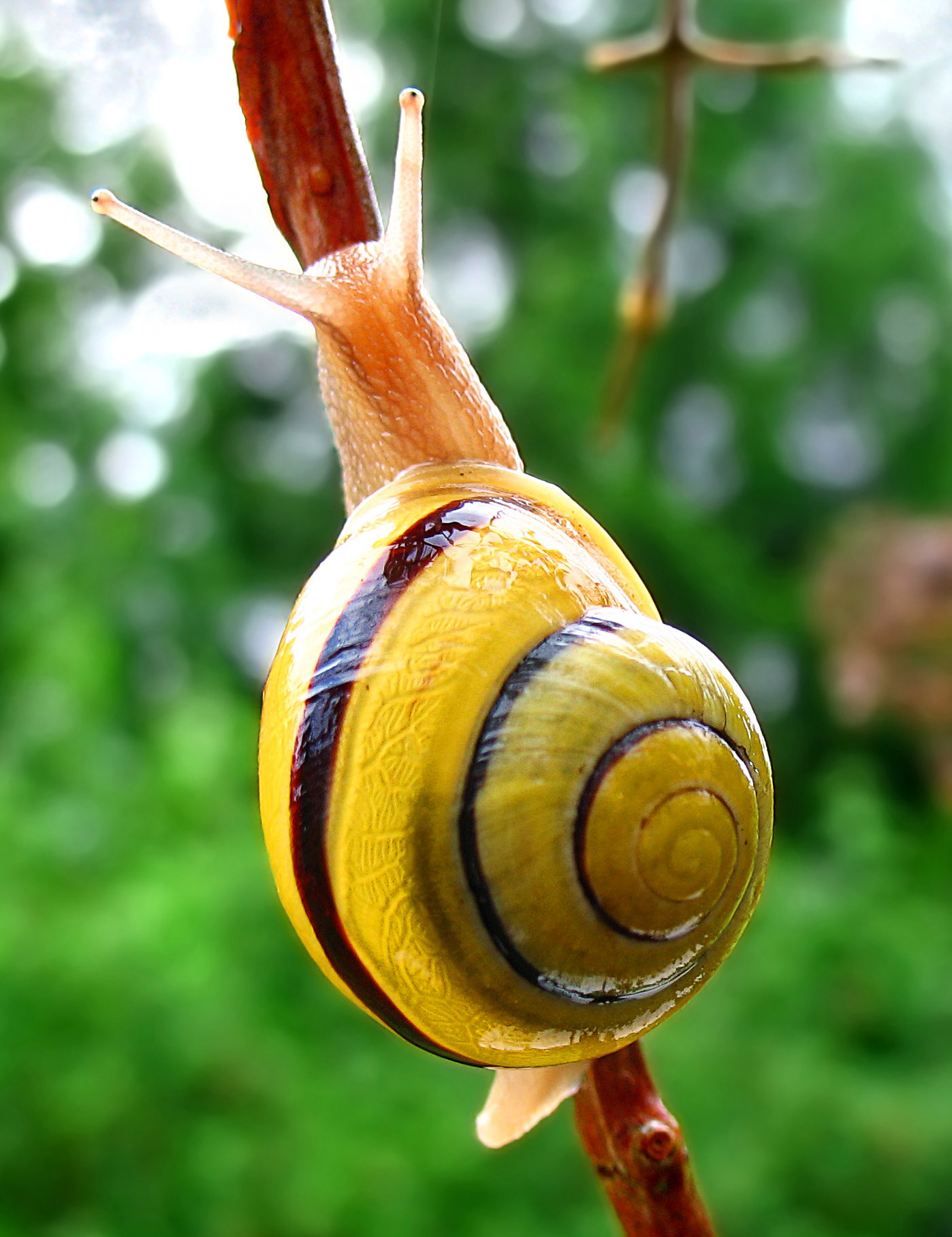
The grove snail or brown-lipped snail (Cepaea nemoralis) on a branch.
By Mad Max
Menno Schilthuizen’s research group at Leiden University tried to answer this question by studying snail pictures from across the Netherlands. Schilthuizen’s lab built an app — SnailSnap — that could be downloaded by anyone with a smartphone. The app had instructions on the kind of snails to take pictures of, which were uploaded to a server and analyzed by an algorithm.
The algorithm classified pictures in three ways: shell color, number of stripes, and environment. After sorting through nearly 8,000 images, it showed that yellow shells were more common in urban areas. This made sense as yellow reflects more sunlight than other colors.
Strangely, it was not snails with the least number of stripes, but ones with an intermediate number that were more populous in cities. This observation directly clashed with the “lighter is better” notion, as stripes are dark bands and having them reduces the shell’s capacity to reflect light. The researchers think they may have stumbled upon a novel way of regulating temperatures, where the snails use a combination of light and dark patterns to adjust heat radiation.
The scientists now plan to expand their project and analyze feather patterns in urban birds, once again enlisting the help of citizens in research. So next time you snap a picture of a pigeon, consider turning it in to these Dutch scientists.
We need to talk about our current global antimicrobial resistance crisis — in a more effective manner
Antimicrobial resistance has been declared a global health threat, but we're running into barriers when it comes to communication
Ake via Rawpixel
Antimicrobial resistance has been declared a global health threat by the World Health Organization and a quick Google search can easily lead you to many other reports and awareness efforts. These resources, in addition to explaining the current issue of antimicrobial resistance, also detail methods to manage and prevent the further spread of drug-resistant microorganisms. But all of this evidence will remain hidden — unless we effectively communicate the contents of these reports to achieve widespread public understanding and support.
Recently, to fill this gap, the Wellcome Trust released a report on how to communicate about antimicrobial resistance.
The report first summarizes current barriers to successful communication. These barriers include how we use multiple terms for antimicrobial resistance (for example antimicrobial versus antibiotic), which doesn’t help to connect different messages into one unifying issue. Media coverage often focuses on specific outbreaks, which also makes it hard for audiences to connect broad causes to resulting events.
In response, the report recommends five principles for effectively communicating about microbial resistance, based on desk research, media analysis, interviews, and public message testing. One suggestion is to frame antimicrobial medicine as undermining all of modern medicine and negatively affecting treatment across several diseases, rather than treating it as a singular health issue, like tuberculosis or MRSA. Additionally, using ‘apocalyptic’ messaging can lack credibility and lead to skepticism with audiences. Instead, the report suggests showing that antimicrobial resistance is not only an issue we are facing in the upcoming future but as an everyday issue in our lives right now. Usng this messaging encourages immediate action.
To me, this report is valuable for addressing the particular global issue of antimicrobial resistance and also more. It is part of a growing body evidence-backed resources for communicating current scientific issues that is incredibly valuable for bridging gaps in sharing knowledge in our communities.




















